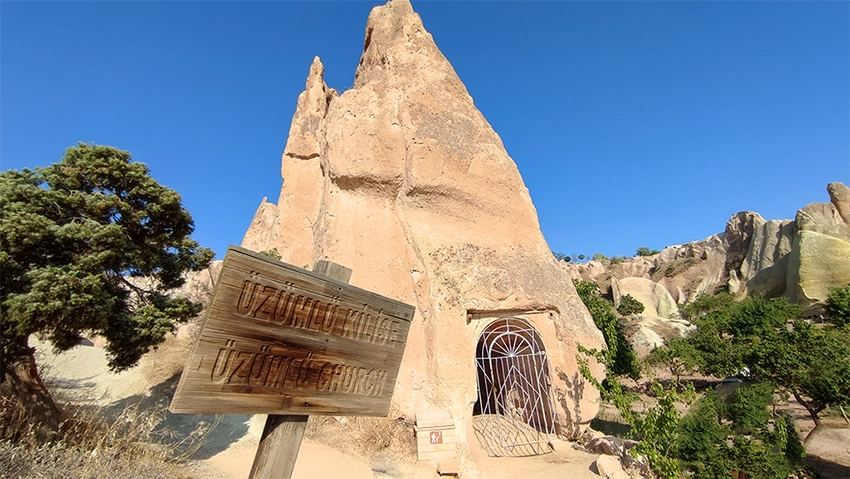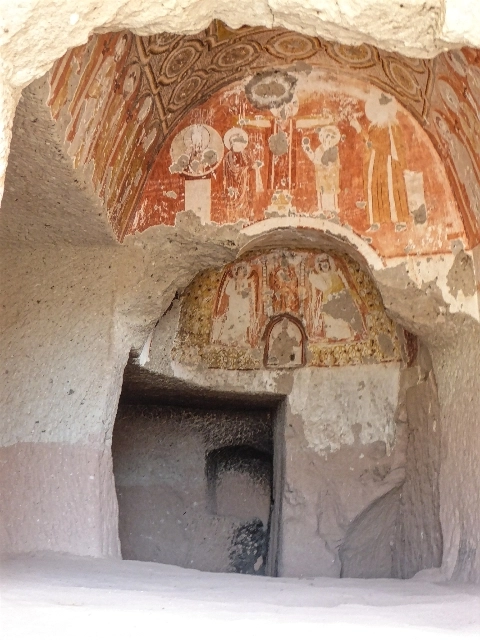Uzumlu Church
Üzümlü (Grape) Church – The Hidden Sanctuary of Red Valley
History and Significance
Üzümlü Church, also known in academic sources as the Chapel of Saint Niketas, is carved into a fairy chimney within Red Valley (Kızılçukur), one of Cappadocia’s most scenic hiking areas. Though small in size, it carries great historical and artistic value.

According to tradition, Saint Niketas, a stylite monk of the 9th century, withdrew here for solitary prayer much like Saint Simeon, who lived atop a column. Over time the site became a place of pilgrimage. One story recounts that a military commander, victorious through the prayers of Niketas, commissioned the chapel and its frescoes in gratitude. Based on its style, the church is dated to the late 9th–early 10th century, placing it among the earliest monastic sanctuaries in Cappadocia.
Architecture and Artistic Features
The church has a single nave with three apses, divided into two sections by two pillars and three arches. On the flat ceiling, a cross motif is carved in relief. This simple symbolism reflects the early Christian preference for geometric and sacred signs.
The church takes its name from the grapevine and cluster frescoes on its walls. Executed mainly in red ochre, the paintings include stylized vine leaves and fruit motifs. This decorative style is similar to other churches of the period, such as Yusuf Koç Church, suggesting a shared workshop.
Frescoes and Iconography
Key scenes include:
- Virgin Mary enthroned with the Child Christ
- The Mandylion (Veronica’s Veil) – Christ’s face miraculously imprinted on a cloth
- Deesis (Christ with Mary and John the Baptist)
- Annunciation, Nativity, Presentation at the Temple, Baptism, Transfiguration
- Armored soldier saints, likely St. George or St. Theodore

Because no plaster was applied, the frescoes were painted directly on the stone. Many colors have faded, but the red outlines remain visible. Their style reflects Byzantine tradition infused with Persian-Arab influences of the era.
Visiting Information
- Location: Red Valley, between Göreme and Ortahisar
- Access: Reachable on foot (20–30 min hike from Göreme), by ATV or horseback tour. Red arrow markers guide visitors through the valley.
- Entrance: Free, unmanned site.
- Path: The church is carved into a high fairy chimney; a short rock staircase leads to the entrance.
Tips for Visitors:
- Wear sturdy hiking shoes.
- Bring a flashlight or strong phone torch; the interior is dim.
- Do not use flash inside protect the frescoes.
- Visit before sunset: the red cliffs of the valley glow dramatically, perfect for photography.
Photo Tips:
- Inside: LED light + long exposure captures details.
- Outside: Frame the fairy chimney against the sunset for silhouettes.
Respect the Site:
- Do not touch frescoes.
- Avoid climbing on the rock surfaces.
- Carry out all litter the church is both a natural and spiritual heritage.
Experience
Üzümlü Church is not just a chapel but a rare testimony of monastic solitude, sacred art, and nature fused into architecture. Sitting quietly inside or outside the fairy chimney, one can still sense the atmosphere of Saint Niketas’s prayers carried by the valley’s wind.



